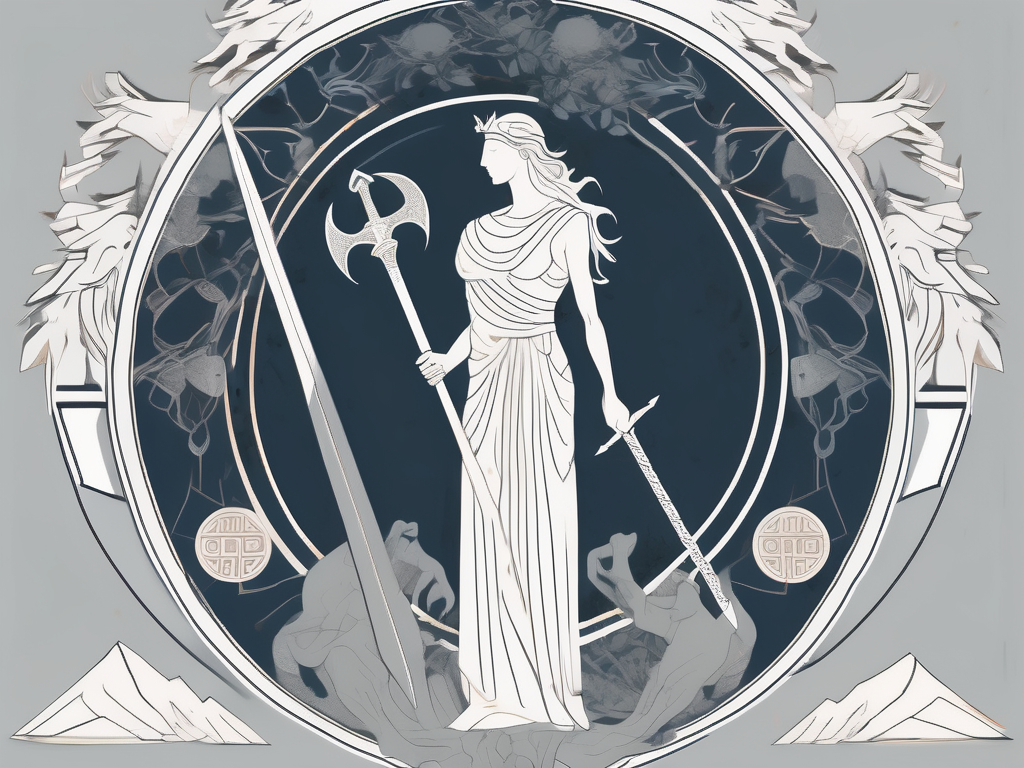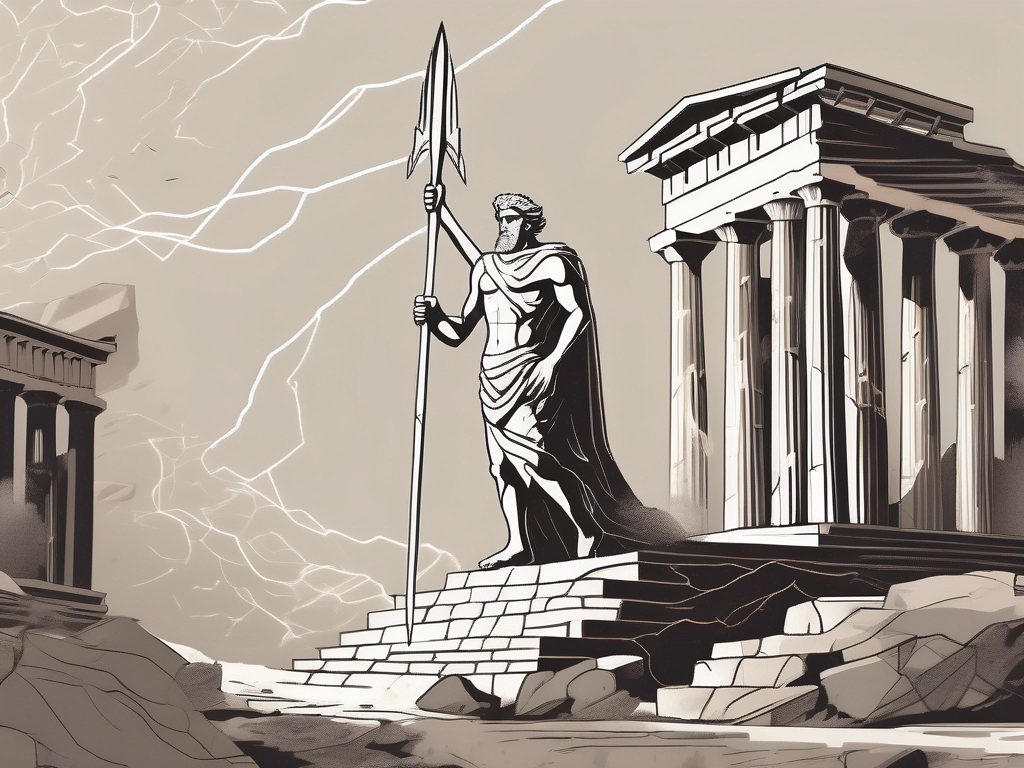Nemesis, the Greek goddess of retribution and balance, has captivated the imaginations of countless individuals throughout history. Her role in Greek mythology is both fascinating and complex, as she embodies the concept of divine justice. In this article, we will delve into the birth and lineage of Nemesis, explore her symbols and representation in ancient Greek culture, and examine her enduring legacy in modern society.
Understanding the Role of Nemesis in Greek Mythology
Before we immerse ourselves in the power and influence of Nemesis, it is essential to grasp her origins and significance in ancient Greek mythology. As the daughter of Nyx, the primordial goddess of night, and Erebus, the personification of darkness, Nemesis was born into a world fraught with cosmic forces.
Nemesis, born from the union of Nyx and Erebus, embodies the delicate equilibrium between revenge and justice. According to legends, she was not only the goddess of retribution but also the enforcer of moral order. This notion becomes even more intriguing when we explore her divine lineage, tracing her ancestry back to Chaos, the primordial void from which all existence sprang.
But what does it mean for Nemesis to be the daughter of Nyx and Erebus? Nyx, the goddess of night, represents the mysterious and unseen aspects of the world. Erebus, on the other hand, personifies darkness and the depths of the underworld. From this union, Nemesis inherits a complex and multifaceted nature, embodying both the hidden and the dark aspects of existence.
As the goddess of retribution, Nemesis played an important role in maintaining cosmic balance. She ensured that individuals who succumbed to hubris, excessive pride or arrogance, faced the consequences of their actions. Nemesis acted as a cosmic force that corrected imbalances and restored equilibrium to both mortals and gods alike.
Imagine a world without Nemesis. It would be a world where no one is held accountable for their actions, where arrogance and injustice run rampant. Nemesis, with her unwavering commitment to justice, ensures that this does not happen. She is the embodiment of divine retribution, the force that keeps the universe in check.
The concept of divine justice was intricately tied to Nemesis. Unlike other gods who ruled over specific domains, she was tasked with preserving the moral fabric of the universe. In Greek mythology, Nemesis symbolized the swift, unrelenting justice that would befall those who defied the natural order or violated the sacred bonds of humanity.
But Nemesis is not a vengeful deity. She does not act out of personal vendettas or petty grievances. Instead, her actions are driven by a deep sense of fairness and the need to restore balance. She is the embodiment of the saying “what goes around, comes around.” Those who commit acts of injustice will inevitably face the consequences, as Nemesis ensures that their actions do not go unpunished.
It is important to note that Nemesis does not only punish mortals. Even the gods themselves are not exempt from her retribution. In Greek mythology, we see numerous examples of gods who overstep their boundaries and face the wrath of Nemesis. This serves as a reminder that no one, not even the divine, is above the laws of justice.
The Power and Influence of Nemesis
As we delve deeper into the power and influence of Nemesis, we uncover the symbols associated with her, explore her portrayal in ancient Greek literature and art, and understand the significance of her temples and worship.
Nemesis, the Greek goddess of retribution and vengeance, held a significant role in the ancient Greek pantheon. Her power and influence extended beyond the realms of mythology, shaping the moral fabric of society and instilling a sense of divine justice.
The Symbols Associated with Nemesis
In art and literature, Nemesis is often depicted with a set of distinctive symbols. Her primary symbols include a pair of scales, signifying the careful weighing of actions and their corresponding consequences, and a bridle, representing her ability to rein in hubris and arrogance. These symbols serve as a reminder of Nemesis’ role in restoring balance and retribution.
The scales, meticulously balanced, reflect the meticulous nature of Nemesis’ judgment. With impartiality, she measures the deeds of mortals, ensuring that each action is met with its rightful consequence. The bridle, on the other hand, symbolizes her power to restrain those who succumb to excessive pride and arrogance. It serves as a warning to individuals who dare to challenge the natural order of things.
Nemesis in Ancient Greek Literature and Art
Nemesis’s influence in ancient Greek literature and art was profound. Mythological tales often portrayed her as a relentless and just force, punishing the prideful and rewarding the virtuous. Artists and poets skillfully captured her essence, immortalizing her in sculptures, paintings, and epic poems, ensuring that the concept of divine justice remained deeply embedded in the collective consciousness of Greek society.
In ancient Greek literature, Nemesis was a recurring character, appearing in various myths and tragedies. She was the driving force behind the downfall of hubristic figures such as Narcissus and Arachne, reminding mortals of the consequences of excessive pride. In art, her portrayal was equally captivating. Sculptors meticulously crafted statues of Nemesis, capturing her stern countenance and unwavering gaze. Painters, too, sought to depict her in their masterpieces, using vibrant colors and intricate brushstrokes to convey her power and presence.
The Temples and Worship of Nemesis
In ancient Greece, Nemesis was not only revered in artworks but also worshipped in dedicated temples. These sanctuaries served as spaces for devotees to pay their respects to the goddess and seek her guidance. The rituals and offerings made in her temples were believed to align mortals with the natural order and promote harmony within society.
Nemesis’ temples were architectural marvels, designed with grandeur and precision. They stood as a testament to the importance of divine justice in Greek culture. Worshipers would enter these sacred spaces, adorned with intricate carvings and adorned with offerings, to seek solace and guidance from the goddess. They would offer prayers and sacrifices, hoping to appease Nemesis and gain her favor.
These rituals were not only acts of devotion but also served as a reminder of the consequences of one’s actions. By engaging in worship, individuals acknowledged the power of Nemesis and the need to maintain a balance in their lives. It was a way to ensure that their actions aligned with the principles of justice and fairness, both in their personal lives and within society as a whole.
Nemesis in Modern Culture and Psychology
Even in the modern age, the allure of Nemesis continues to resonate in our collective consciousness. Her archetype can be found in various forms of artistic expression, and her psychological influence, known as the ‘Nemesis complex,’ is still a subject of psychological analysis.
The Archetype of Nemesis in Modern Literature and Film
Nemesis’s enduring legacy can be observed in contemporary literature and film, where her archetype often appears as a powerful force seeking to restore balance. From classic novels to blockbuster movies, this archetype serves as a reminder of the consequences that befall those who overstep their limits or act without regard for others.
In recent years, the archetype of Nemesis has been portrayed in popular novels such as “Gone Girl” by Gillian Flynn. The character of Amy Dunne embodies the spirit of Nemesis as she meticulously plans her revenge against her unfaithful husband, Nick. Through her actions, Amy becomes the embodiment of divine justice, ensuring that those who have wronged her face the consequences of their actions.
Similarly, in the world of film, the archetype of Nemesis can be seen in movies like “The Dark Knight” where the character of Batman takes on the role of a vigilante seeking to restore balance in Gotham City. Batman’s relentless pursuit of justice and his unwavering commitment to upholding moral principles make him a modern-day representation of Nemesis.
The Psychological Concept of the ‘Nemesis Complex’
Psychologists have explored the ‘Nemesis complex,’ a term used to describe the subconscious drive for balance and justice that exists within individuals. This complex refers to those moments when individuals feel an innate need to see justice prevail, even if they are not directly involved in the situation at hand. Understanding this psychological phenomenon gives us valuable insights into the enduring power of Nemesis in our lives.
Research in psychology has shown that the Nemesis complex can manifest in various ways. For some individuals, it may be a strong sense of empathy and a desire to see fairness in the world. They feel a deep connection to the concept of justice and are driven to take action when they witness injustice. Others may experience the Nemesis complex as a personal need for retribution, seeking to right the wrongs they have experienced in their own lives.
Moreover, the Nemesis complex can also be observed on a societal level. Movements for social justice, such as the civil rights movement or the fight against climate change, can be seen as collective expressions of the Nemesis complex. These movements arise from a shared belief in the need for balance and justice, and a collective desire to rectify past wrongs.
The Enduring Legacy of Nemesis in Contemporary Society
As we conclude our journey into the power and mythology of Nemesis, we must reflect on the enduring legacy she leaves behind. The concept of divine justice, as personified by Nemesis, continues to shape our collective moral compass. From legal systems that seek to balance retribution and rehabilitation to societal movements aimed at rectifying past wrongs, the influence of Nemesis remains ever-present in our pursuit of fairness and equilibrium.
In contemporary society, the influence of Nemesis can be seen in various aspects of our lives. For example, the concept of restorative justice, which focuses on repairing harm caused by crime rather than solely punishing the offender, reflects the underlying principles of balance and retribution embodied by Nemesis.
Furthermore, the Nemesis complex continues to shape our understanding of human behavior and motivation. Psychologists and researchers continue to explore the intricate relationship between justice, fairness, and the human psyche, drawing inspiration from the enduring legacy of Nemesis.
In conclusion, Nemesis, the Greek goddess of retribution and balance, holds a significant place in ancient mythology and continues to captivate us today. From her birth and lineage to her role in enforcing cosmic justice, Nemesis reminds us of the delicate balance that governs our actions and their consequences. Her symbols, portrayal in art and literature, and the temples dedicated to her worship are testaments to her enduring influence. Furthermore, her archetype and the ‘Nemesis complex’ in modern culture and psychology highlight the deep-rooted need for justice and balance within the human psyche. As we navigate contemporary society, let us remember the power and mythology of Nemesis, and strive to uphold the principles of fairness and retribution that she represents.












